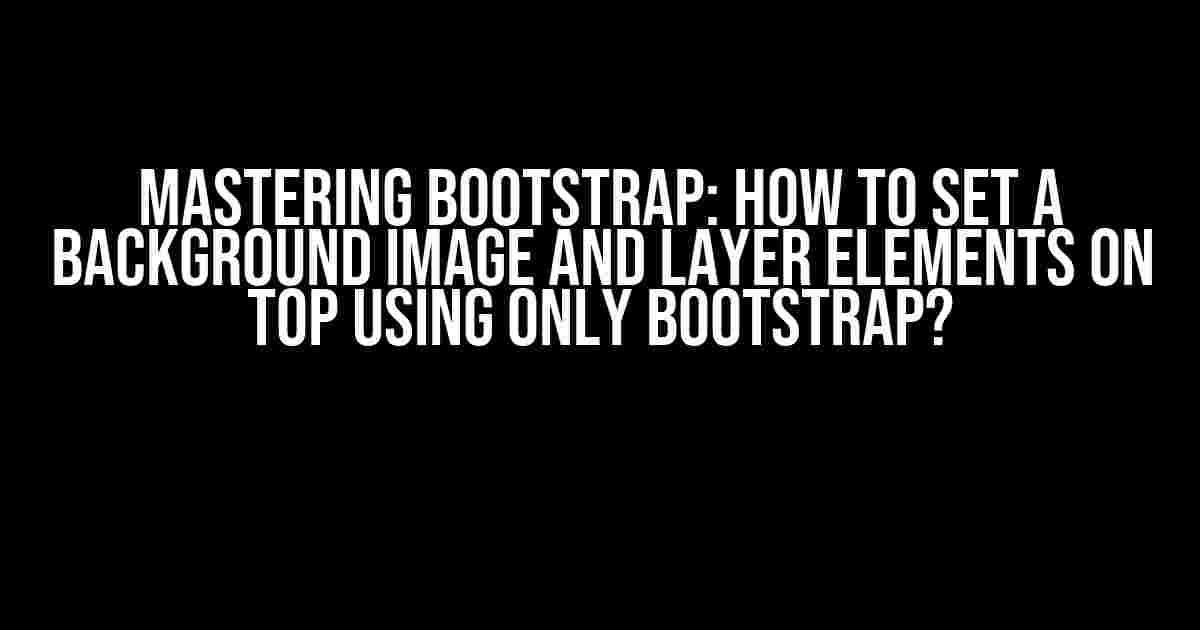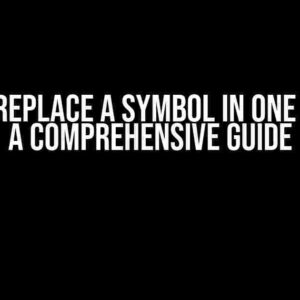Welcome to the world of Bootstrap, where coding magic happens! In this article, we’re going to dive into the nitty-gritty of setting a background image and layering elements on top using only Bootstrap. Yes, you read that right – NO CSS CODE REQUIRED! So, grab your favorite code editor, and let’s get started!
What You’ll Need
To follow along, you’ll need a basic understanding of HTML and Bootstrap. If you’re new to Bootstrap, don’t worry; we’ll cover the essentials as we go. Grab a cup of coffee, and let’s get bootstrapped!
Step 1: Set Up Your Bootstrap Project
First things first, we need to set up our Bootstrap project. You can either download the Bootstrap framework from the official website or use a CDN link. For this example, we’ll use the CDN link.
<link rel="stylesheet" href="https://maxcdn.bootstrapcdn.com/bootstrap/4.0.0/css/bootstrap.min.css">
Add this line to the head section of your HTML file, and you’re good to go!
Step 2: Create a Container
Next, we need to create a container to hold our background image and layered elements. We’ll use the Bootstrap grid system to create a full-width container.
<div class="container-fluid"> </div>
This will create a full-width container that spans the entire width of the viewport.
Step 3: Add a Background Image
Now, let’s add a background image to our container. We’ll use the Bootstrap `.bg-image` class to set the background image.
<div class="container-fluid bg-image"> <img src="your-background-image.jpg" alt="Background Image" class="img-fluid"> </div>
Replace `your-background-image.jpg` with the path to your desired background image. The `.img-fluid` class will ensure our image is responsive and scales with the container.
Step 4: Layer Elements on Top
Now that we have our background image in place, it’s time to layer some elements on top. We’ll use the Bootstrap `.overlay` class to create an overlay container.
<div class="container-fluid bg-image">
<img src="your-background-image.jpg" alt="Background Image" class="img-fluid">
<div class="overlay">
</div>
</div>
The `.overlay` class will create a full-width, full-height container that overlays our background image.
Step 5: Add Layered Elements
Finally, let’s add some layered elements on top of our background image. We’ll use Bootstrap’s grid system to create a simple layout.
<div class="container-fluid bg-image">
<img src="your-background-image.jpg" alt="Background Image" class="img-fluid">
<div class="overlay">
<div class="row justify-content-center">
<div class="col-md-6 text-center">
<h2>Layered Element</h2>
<p>This is a layered element on top of our background image!</p>
</div>
</div>
</div>
</div>
In this example, we’ve added a simple heading and paragraph element on top of our background image. You can customize the layout and add more elements as needed.
Tips and Tricks
Here are some additional tips and tricks to take your Bootstrap skills to the next level:
- Customize Your Background Image: Use the `.bg-image` class with additional classes like `.bg-cover` or `.bg-contain` to customize the background image behavior.
- Adjust Overlay Opacity: Use the `.Overlay-op8` class to adjust the opacity of your overlay container.
- Use Bootstrap Utilities: Bootstrap provides a range of utility classes to simplify your coding. Explore the official Bootstrap documentation to learn more.
Common Issues and Solutions
Here are some common issues you might encounter and their solutions:
| Issue | Solution |
|---|---|
| Background image not showing | Check the image path and ensure it’s correct. Also, make sure the `.bg-image` class is applied correctly. |
| Overlay not covering the entire container | Verify that the `.overlay` class is applied to a container that spans the entire width and height of the parent element. |
| Layered elements not showing | Check the z-index of your layered elements and ensure they’re not being hidden by other elements. |
Conclusion
And that’s it! You’ve successfully set a background image and layered elements on top using only Bootstrap. Pat yourself on the back, and go forth to create more Bootstrap magic!
Remember, the key to mastering Bootstrap is to practice, practice, practice. Experiment with different classes, utilities, and layouts to take your skills to the next level.
Happy coding, and don’t forget to share your Bootstrap creations with the world!
Stay tuned for more Bootstrap tutorials and articles!Here are 5 Questions and Answers about “How to Set a Background Image and Layer Elements on Top Using Only Bootstrap”:
Frequently Asked Question
Want to add some flair to your Bootstrap design? Learn how to set a background image and layer elements on top using only Bootstrap with these frequently asked questions!
How do I set a background image using Bootstrap?
To set a background image using Bootstrap, you can add the `.bg-img` class to a container element, such as a `div`, and then use the `style` attribute to specify the background image URL. For example: `
`. You can also use the `jumbotron` class to create a full-width background image.
How do I layer elements on top of a background image in Bootstrap?
To layer elements on top of a background image in Bootstrap, you can use the `.overlay` class on a container element, such as a `div`, and then add your elements inside it. You can also use the `position` property to set the position of the elements to `relative` or `absolute` to layer them on top of the background image.
Can I use a full-width background image with a Bootstrap container?
Yes, you can use a full-width background image with a Bootstrap container by adding the `.container-fluid` class to the container element, which will make it full-width, and then adding the background image to the container using the `style` attribute or the `jumbotron` class.
How do I center elements on top of a background image in Bootstrap?
To center elements on top of a background image in Bootstrap, you can use the `.text-center` class to horizontally center the elements, and then use the `margin` property to vertically center them. You can also use the `.flex` class to create a flexbox container and center the elements using the `justify-content` property.
Can I use a responsive background image with Bootstrap?
Yes, you can use a responsive background image with Bootstrap by adding the `.img-fluid` class to the background image element, which will make it responsive and scale according to the screen size. You can also use media queries to define different background image sizes for different screen sizes.
Let me know if you need anything else!




